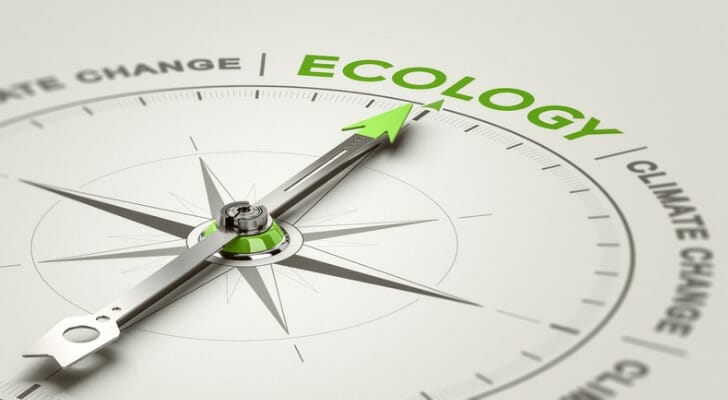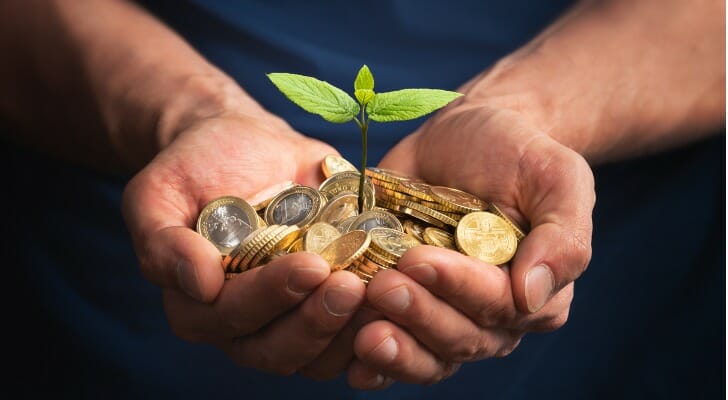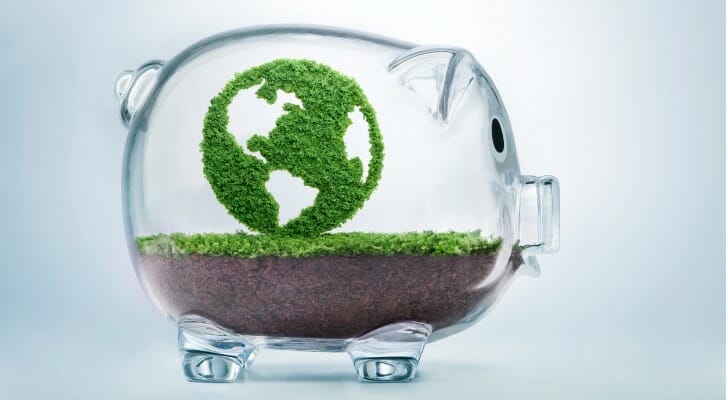Green investments support companies, governments, and organizations that promote environmentally friendly practices. Those practices may include natural habitat preservation, green building, water conservation, and production or distribution of renewable energy. Green investing is often associated with socially responsible investing (SRI), though SRI extends to more than just environmental causes. There are different ways to promote green investing in a portfolio, including investing in individual stocks as well as exchange-traded funds (ETFs), mutual funds, and green bonds.
A financial advisor can help you make your portfolio green with an array of securities that support sustainable ventures.
Green Investment Definition
Broadly speaking, a green investment is an investment that directly or indirectly supports environmental causes. It is a subset of socially responsible investing, which is also related to environmental, social and governance (ESG) investing principles. An investor who’s interested in ESG would choose investments that support environmental causes, as well as social and governance issues.
A green investor, on the other hand, may be interested solely in investments that promote a cleaner, healthier natural environment. It’s important to understand that distinction since green investment is often grouped together with socially responsible investing or impact investing, though each has different aims.
Green investors actively support environmental cleanup, management, and preservation while also getting a financial reward in the form of returns on those investments. For example, an investor who buys stock in a green company may benefit from both capital gains and dividend payments.
Green Investment Characteristics
The green investment label can be applied to a number of different securities. For example, it’s possible to invest in:
- Stocks of companies that promote sustainability and green practices
- Environmentally friendly mutual funds or ETFs
- Green bonds
- Green real estate investment trusts
So what makes an investment green?
In a general sense, it’s a commitment to supporting green practices. So, for example, a company that only relies on renewable energy sources and is actively engaged in water conservation may fit the bill for green investment. Likewise, a real estate investment trust (REIT) that invests in properties with environmentally-friendly upgrades or improvements may be an attractive target for eco-conscious investors.
Within this category exists a subset of investments that are pure play. This means that the majority of revenues and profits stem directly from green activities. So a company that only produces solar panels, for example, may be considered a pure play green investment. A green bond could also be categorized as pure play if all of the money offered by investors to fund the bond is used for green projects.
Benefits of Green Investing
Investing with an environmental focus can help investors achieve two goals. First, it’s an opportunity to support environmentally friendly practices. You may feel better about putting your money behind a company that’s actively engaged in supporting wildlife preservation or mitigating negative impacts of climate change versus investing in one that’s known to be a major contributor to air or water pollution.
Next, you can benefit financially from your investments over time. With green bonds, for example, you can enjoy fixed income in the form of interest payments. Since green bonds are often associated with entities that have strong credit ratings, the risk of default is generally low. Green bonds can also be tax-exempt, which yields another benefit to investors.
Investing in green stocks can allow you to reap dividends if the company pays them. And if the company’s stock rises in value you can collect capital gains once you decide to sell. Buying ETFs or mutual funds that have a green focus also makes it easier to diversify and manage risk within your portfolio.
Green Investing Challenges
The biggest issue with green investing is that there’s a certain amount of gray area that exists concerning what is or isn’t a green investment. Companies can claim to be environmentally friendly in order to attract the support of investors but that isn’t always the case. Greenwashing is a common tactic that companies can use to make themselves appear more eco-conscious than they actually are.
This practice involves using misleading messaging or claims. For example, a fast-food chain may tout the use of recycled cardboard for its packaging materials. But this could be a diversionary tactic to draw attention away from the fact that the beef it sources for its products is a major contributor to methane emissions. Or a company that produces soft drinks and bottled water may publicly promote sustainable practices while being a major plastic polluter.
This places a heavier burden on investors to perform their due diligence when choosing green investments to confirm that they’re actually eco-friendly and not simply greenwashed. Reading through a company’s prospectus is a good place to start to identify companies that are truly green. You can also check out the company’s website to see what kind of sustainability practices it promotes.
How to Build a Portfolio With Green Investments
If you’re interested in supporting the environment with your portfolio, the first step is setting up a place to invest. An online brokerage account gives you access to stocks, ETFs, mutual funds and bonds, and most major brokers now offer commission-free trading. Once your account is ready, the decision is which types of green investments you want to include. Options range from renewable energy and sustainable building to water conservation, recycling, and climate change mitigation.
For example, this could include:
- Solar industry
- Wind energy
- Wildlife and habitat preservation
- Climate change mitigation
- Water conservation
- Green building
- Biofuels
- Recycling
The next step is research. Not every company or fund marketed as “green” meets high environmental standards, and greenwashing is common. Before buying, look closely at what your investment dollars are funding. For green bonds, review the projects tied to the bond. For ETFs or mutual funds, examine the holdings to confirm that they include companies with real commitments to sustainability. Careful screening helps avoid supporting businesses that only appear eco-friendly.
After selecting the right securities, consider how they fit into your overall portfolio. Green stocks and ETFs can tilt your portfolio toward industries positioned for future growth, while green bonds can provide steady income and stability. The balance matters: concentrating too much in one market sector can increase volatility, while measured allocations can diversify your portfolio and provide both financial and environmental benefits.
Green investing works best when treated as part of your broader plan. It is not a separate strategy but a layer applied to your existing mix of investments. By combining careful research with thoughtful allocation, you can build an investment portfolio that supports sustainability while still advancing your long-term financial goals.
Bottom Line

As concerns over climate change grow, more money may begin to flow into green investments. Whether green investing is right for you can depend on your short- and long-term goals. As with any other investment, it’s important to understand the potential risks and rewards involved.
Tips for Investing
- Consider talking to a financial advisor about the pros and cons of green investment strategies and how you might implement them in your portfolio. If you don’t have a financial advisor yet, finding one doesn’t have to be hard. SmartAsset’s financial advisor matching tool matches you with vetted financial advisors who serve your area, and you can have a free introductory call with your advisor matches to decide which one you feel is right for you. If you’re ready to find an advisor who can help you achieve your financial goals, get started now.
- Want to take a look at what your portfolio will look like in a decade? SmartAsset’s investment calculator can help you do just that. Enter how much you have invested, how much you’re contributing and what rate of return you expect. We’ll then show you your investment growth five, 10 or even 30 years into the future.
- When investing in ETFs or mutual funds, pay attention to the fees you might pay and how often fund assets turn over. The expense ratio can dictate how much you’ll pay to own a green ETF or fund on a yearly basis; the lower this number is, the better. Funds that have a higher turnover ratio because they follow an active management strategy may carry higher expense ratios as a result. Passive funds, on the other hand, may change out assets less often and have lower fees.
Photo credit: ©iStock.com/AlexSava, ©iStock.com/Pogonici, ©iStock.com/Olivier Le Moal

